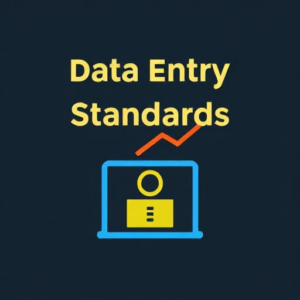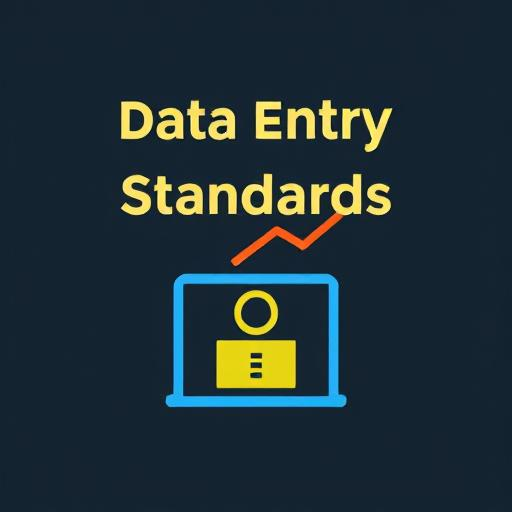Data Entry Standards and Best Practices
Data Entry Standards and Best Practices
Effective data entry is essential for maintaining accurate, clean, and consistent information within any system. Adhering to data entry standards and best practices can help prevent errors, improve efficiency, and ensure data integrity. Below are key standards and best practices for data entry:
1. Consistent Formatting
- Uniform Date Formats: Standardize how dates are entered (e.g., MM/DD/YYYY or YYYY-MM-DD) and ensure consistency across all records.
- Standardized Units: Define how units of measurement should be entered, such as using “kg” for kilograms or “ft” for feet.
- Case Sensitivity: Decide whether text should be capitalized (e.g., names of people, countries) or remain in lowercase, and apply this consistently.
- Address Formatting: Use a uniform format for addresses, such as always putting the street number first, followed by the street name and then the city or town.
2. Accuracy and Attention to Detail
- Verify Information: Double-check all entries for spelling, typos, and missing data before submitting or saving.
- Use Data Validation Tools: Where possible, use software tools or scripts to validate data automatically (e.g., checking for invalid email addresses, phone numbers, or postal codes).
- Confirm Data from Reliable Sources: Ensure that data comes from trusted and accurate sources, especially when manually entering data.
3. Avoiding Duplication
- Duplicate Entry Detection: Set up checks to prevent entering duplicate records (e.g., matching names, addresses, or emails).
- Consolidate Data: If a duplicate is detected, review the records to combine them, keeping the most up-to-date information while removing redundancy.
4. Maintain Data Consistency
- Standardize Terminology: Create a set of defined terms or codes (e.g., using “M” for male and “F” for female, or a consistent classification system for products or services).
- Drop-down Menus & Predefined Lists: Whenever possible, use dropdowns or predefined lists to limit free-text entries, reducing variability and errors.
5. Data Privacy and Confidentiality
- Limit Access to Sensitive Data: Ensure that only authorized personnel can access and edit sensitive or personal data.
- Secure Data Storage: Use secure systems for storing and backing up data to prevent unauthorized access and data loss.
- Compliance with Regulations: Ensure that data entry practices comply with relevant regulations such as GDPR, HIPAA, or other local data protection laws.
6. Data Entry Speed & Efficiency
- Keyboard Shortcuts: Encourage using keyboard shortcuts and other tools to speed up the data entry process.
- Batch Data Entry: Whenever possible, input data in batches to minimize time spent switching between systems or formats.
- Templates and Forms: Use pre-designed templates and forms to streamline the entry process and ensure consistency.
7. Regular Data Auditing and Quality Checks
- Scheduled Reviews: Perform regular audits and reviews of data entries to identify inconsistencies, gaps, or errors.
- Data Cleansing: Periodically clean the data by removing outdated, incorrect, or irrelevant entries, and standardizing formats.
8. Training and Documentation
- Training for Data Entry Personnel: Regularly train staff on best practices and the importance of accurate data entry.
- Clear Guidelines: Provide clear, documented guidelines for all staff involved in data entry, outlining expected formats, naming conventions, and validation processes.
9. Use of Technology and Automation
- Automated Data Entry Tools: When possible, utilize OCR (Optical Character Recognition), voice recognition, or other automation tools to reduce manual data entry.
- Integration with Other Systems: Integrate data entry systems with other software tools to reduce manual entry, such as pulling customer information from a CRM or using inventory management systems that automatically update stock levels.
10. Handling Error Reports and Corrections
- Error Logging: Implement a system for logging and tracking data entry errors.
- Clear Correction Procedures: Establish a clear and standardized procedure for correcting errors, including who is responsible and the steps for correction.
11. Providing Feedback
- Feedback Mechanisms: Provide feedback to data entry personnel when errors are identified to help improve their skills and avoid future mistakes.
- Continuous Improvement: Foster a culture of continuous improvement, allowing employees to suggest ways to streamline or enhance the data entry process.
12. Backup and Recovery
- Regular Backups: Ensure regular backups of data are made to prevent loss in case of system failures.
- Disaster Recovery Plans: Develop and maintain disaster recovery plans for data recovery in case of data breaches or other catastrophic events.
By following these standards and best practices, businesses can maintain high-quality data that supports decision-making, reporting, and analysis.

We are also on Facebook
Go back to home page: www.mistyinfotech.com
If you want to Direct Data Entry Projects with Company with Us Please go here: Direct Data Entry Projects with Company







